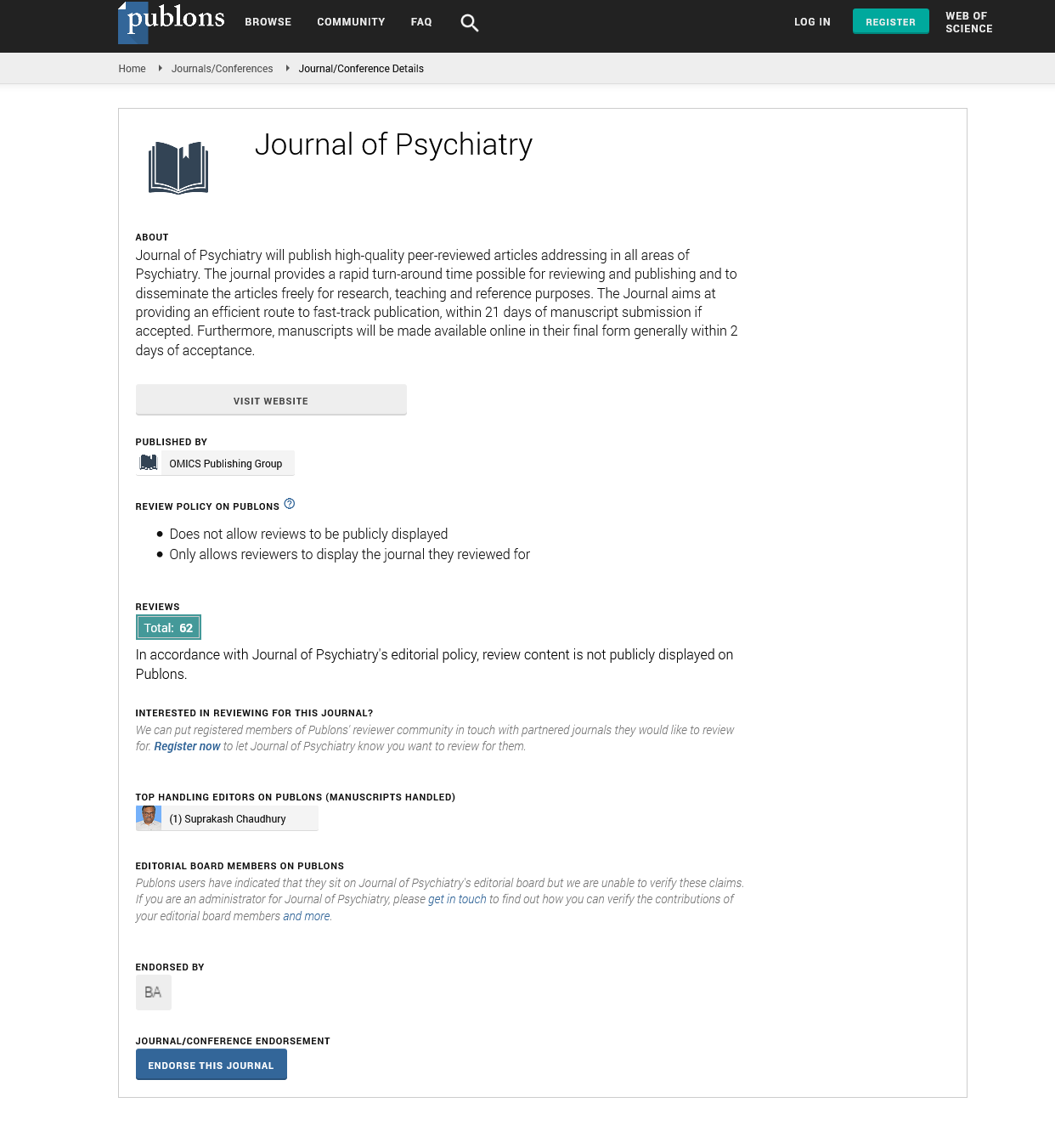Indexed In
- RefSeek
- Hamdard University
- EBSCO A-Z
- OCLC- WorldCat
- SWB online catalog
- Publons
- International committee of medical journals editors (ICMJE)
- Geneva Foundation for Medical Education and Research
Useful Links
Share This Page
Open Access Journals
- Agri and Aquaculture
- Biochemistry
- Bioinformatics & Systems Biology
- Business & Management
- Chemistry
- Clinical Sciences
- Engineering
- Food & Nutrition
- General Science
- Genetics & Molecular Biology
- Immunology & Microbiology
- Medical Sciences
- Neuroscience & Psychology
- Nursing & Health Care
- Pharmaceutical Sciences
Commentary - (2024) Volume 27, Issue 3
Antipsychotics: Potential Role in the Treatment of Neurodevelopmental Disorders
Marku M Rutz*Received: 03-May-2024, Manuscript No. JOP-24-25809; Editor assigned: 06-May-2024, Pre QC No. JOP-24-25809 (PQ); Reviewed: 20-May-2024, QC No. JOP-24-25809; Revised: 27-May-2024, Manuscript No. JOP-24-25809 (R); Published: 03-Jun-2024, DOI: 10.35248/2378-5756.24.27.688
Description
Neurodevelopmental disorders encompass a group of conditions characterized by impairments in cognitive, motor, and social functioning that arise during early development. This explore the Conditions such as Autism Spectrum Disorder (ASD), Attention-Deficit/Hyperactivity Disorder (ADHD), and Intellectual Disability (ID) present unique challenges in management, often requiring a multimodal approach. Antipsychotic medications, traditionally used in the treatment of psychotic disorders like schizophrenia, have also found utility in managing symptoms associated with certain neurodevelopmental disorders. This examines the role of antipsychotics in the management of neurodevelopmental disorders, exploring their effectiveness, safety, and clinical considerations.
Antipsychotics in Autism Spectrum Disorder (ASD)
Autism spectrum disorder is a neurodevelopmental disorder characterized by persistent deficits in social communication and interaction, as well as restricted interests and repetitive behaviors. While antipsychotic medications are not approved by the FDA (Food and Drug Administration) for the core symptoms of ASD, they are often prescribed off-label to target specific symptoms, such as aggression, irritability, and repetitive behaviors. Atypical antipsychotics, including risperidone and aripiprazole, have shown efficacy in reducing irritability and aggression in children and adolescents with ASD, leading to improved functional outcomes and quality of life for some individuals.
Antipsychotics in Attention-Deficit/Hyperactivity Disorder (ADHD)
Attention-deficit/hyperactivity disorder is a neurodevelopmental disorder characterized by persistent patterns of inattention, hyperactivity, and impulsivity that impair daily functioning. While stimulant medications, such as methylphenidate and amphetamines, are first-line treatments for ADHD, antipsychotic medications may be considered as second-line or adjunctive options in cases where stimulants are ineffective or poorly tolerated. Antipsychotics, particularly those with alpha-2 adrenergic antagonist properties, such as guanfacine and clonidine, have shown efficacy in managing ADHD symptoms, particularly in children with comorbid aggression or oppositional behavior.
Antipsychotics in Intellectual Disability (ID)
Intellectual disability is a neurodevelopmental disorder characterized by significant limitations in intellectual functioning and adaptive behavior, which manifests during the developmental period. Individuals with ID may experience behavioral disturbances, mood symptoms, and aggression that can significantly impact their quality of life and social functioning. Antipsychotic medications, particularly second- generation antipsychotics like risperidone and aripiprazole, are commonly prescribed off-label to manage behavioral symptoms associated with ID, such as aggression, self-injury, and irritability. While antipsychotics may provide symptom relief in some cases, their use in ID should be carefully monitored due to the risk of adverse effects, including metabolic disturbances and extrapyramidal symptoms.
While antipsychotic medications may offer symptom relief in certain neurodevelopmental disorders, their use should be guided by careful clinical assessment and consideration of potential risks and benefits. Clinicians should conduct a thorough evaluation of the individual's symptoms, comorbid conditions, treatment history, and functional impairment before initiating antipsychotic therapy. Additionally, regular monitoring of treatment response, symptom severity, and adverse effects is essential to ensure optimal outcomes and minimize potential harm. Antipsychotic medications are associated with a range of potential adverse effects, including weight gain, metabolic disturbances (e.g. dyslipidemia, hyperglycemia), extrapyramidal symptoms (e.g. akathisia, tardive dyskinesia), and cardiovascular effects (e.g. QT interval prolongation). Children and adolescents may be particularly vulnerable to these adverse effects, underscoring the importance of careful monitoring and risk mitigation strategies. Clinicians should educate patients and families about potential side effects, monitor metabolic parameters regularly, and consider lifestyle modifications and adjunctive interventions to mitigate adverse effects and optimize treatment outcomes.
The use of antipsychotic medications in the management of neurodevelopmental disorders represents an evolving area of research and clinical practice. Future studies should focus on identifying biomarkers, genetic predictors, and neurobiological mechanisms underlying treatment response and adverse effects to inform personalized treatment approaches. Additionally, research into alternative pharmacological and non- pharmacological interventions, such as novel medications, targeted therapies, and psychosocial interventions, may offer additional treatment options for individuals with neurodevelopmental disorders.
In conclusion, antipsychotic medications play a role in the management of certain neurodevelopmental disorders, offering symptom relief for specific behavioral disturbances and comorbid conditions. While antipsychotics may provide benefits in some cases, their use should be guided by careful clinical assessment, consideration of potential risks and benefits, and regular monitoring of treatment response and adverse effects. By adopting a personalized and evidence-based approach to treatment, clinicians can optimize outcomes and improve the quality of life for individuals with neurodevelopmental disorders.
Citation: Rutz MM (2024) Antipsychotics: Potential Role in the Treatment of Neurodevelopmental Disorders. J Psychiatry. 27:688.
Copyright: © 2024 Rutz MM. This is an open access article distributed under the terms of the Creative Commons Attribution License, which permits unrestricted use, distribution, and reproduction in any medium, provided the original author and source are credited.

